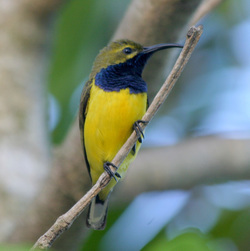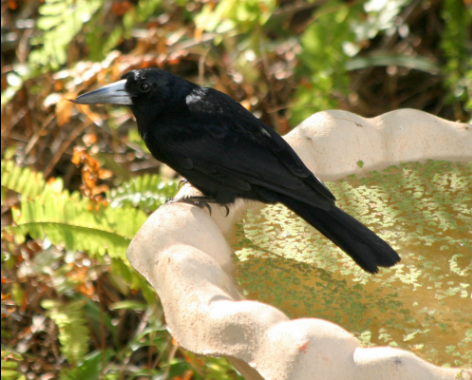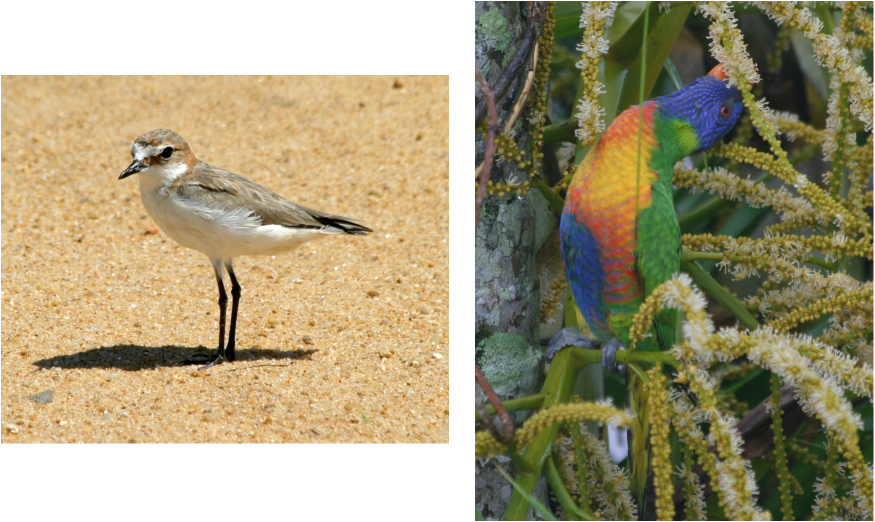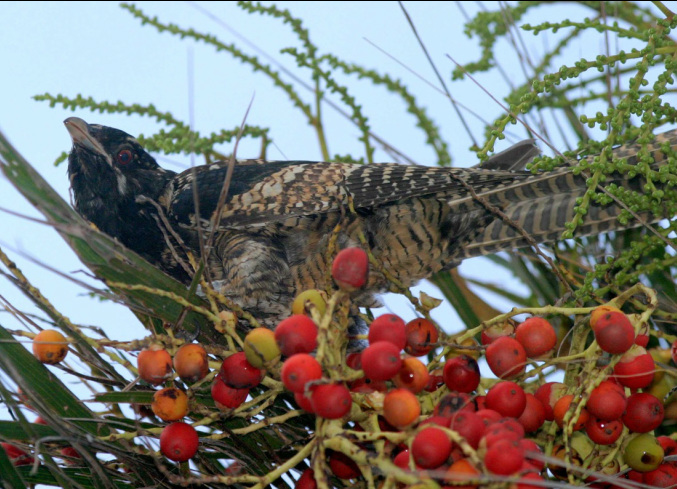Birds And Places To See Them
Wongaling Beach 'Beach-nesting Birds'
Records and Threats Profile: 9 September 2023 – 30 November 2023
Here's the latest report on the Wongaling Beach bird monitoring
Threat percentages have barely budged, but have noted the observations of bicycles above high tide mark which is a definite risk to the terns (I wouldn't trust myself to dodge a tern chick on a bicycle!)
A couple extra threatened shorebirds on the list now as well.
Just as an aside, Little Terns more broadly have known nests at five locations between Cairns and Ingham, but as of now we haven't found more than 4 nests at any of these places.
Download the file below for more detailed information.
Records and Threats Profile: 9 September 2023 – 30 November 2023
Here's the latest report on the Wongaling Beach bird monitoring
Threat percentages have barely budged, but have noted the observations of bicycles above high tide mark which is a definite risk to the terns (I wouldn't trust myself to dodge a tern chick on a bicycle!)
A couple extra threatened shorebirds on the list now as well.
Just as an aside, Little Terns more broadly have known nests at five locations between Cairns and Ingham, but as of now we haven't found more than 4 nests at any of these places.
Download the file below for more detailed information.
| Wongaling Beach 9 Sep - 30 Nov 2023_bnb_and_threats_report.pdf | |
| File Size: | 269 kb |
| File Type: | |
Wongaling Beach 'Beach-nesting Birds'
Records and Threats Profile: 9 September 2023 – 18 October 2023
Our team of monitors from the local area have conducted 21 surveys here in 7 weeks, as the area comes into the breeding season. 20 species have been recorded, including two beach-nesting species (Red-capped Plover and Little Tern) a migratory shorebird (Lesser Sand Plover) and three coastal raptors (Osprey, Brahminy Kite and White-bellied Sea-Eagle).
The Red-capped Plover is still a resident beach-nesting bird at Wongaling Beach. Numbers fell in October, coinciding with an algal bloom. Ospreys were also frequently reported, as the beach is part of a known territory for these raptors. Lesser Sand Plovers are an Endangered migratory shorebird.
The biggest threat came from off-leash dogs - encountered on 50% of surveys even though the area is designated as on-leash. Download the file below for more detailed information.
Records and Threats Profile: 9 September 2023 – 18 October 2023
Our team of monitors from the local area have conducted 21 surveys here in 7 weeks, as the area comes into the breeding season. 20 species have been recorded, including two beach-nesting species (Red-capped Plover and Little Tern) a migratory shorebird (Lesser Sand Plover) and three coastal raptors (Osprey, Brahminy Kite and White-bellied Sea-Eagle).
The Red-capped Plover is still a resident beach-nesting bird at Wongaling Beach. Numbers fell in October, coinciding with an algal bloom. Ospreys were also frequently reported, as the beach is part of a known territory for these raptors. Lesser Sand Plovers are an Endangered migratory shorebird.
The biggest threat came from off-leash dogs - encountered on 50% of surveys even though the area is designated as on-leash. Download the file below for more detailed information.
| Wongaling Beach Sept.-Oct.2023 BNB and Threats Report.pdf | |
| File Size: | 249 kb |
| File Type: | |
Mission Beach Birding
Why Go Birding Around Mission Beach?
This is a great spot for a birdwatcher – it’s close to rainforest, rivers, estuaries, sandy beaches, rocky headlands, offshore islands, human-made plantations and the high country of the Tablelands. This mix of habitats and altitudes makes it a fascinating place to spend quite a few days, to see many of the Wet Tropics special birds and get the feel of the environment. Even manicured gardens may attract over 20 species, and it is just a short walk to see birds like fruit-doves, pittas, riflebirds, shrike-thrushes and stone-curlews. In the monsoon (Wet) season, Greater and Lesser Frigatebirds may sail along the coast, getting out of the way of an incoming cyclone.
Why Go Birding Around Mission Beach?
This is a great spot for a birdwatcher – it’s close to rainforest, rivers, estuaries, sandy beaches, rocky headlands, offshore islands, human-made plantations and the high country of the Tablelands. This mix of habitats and altitudes makes it a fascinating place to spend quite a few days, to see many of the Wet Tropics special birds and get the feel of the environment. Even manicured gardens may attract over 20 species, and it is just a short walk to see birds like fruit-doves, pittas, riflebirds, shrike-thrushes and stone-curlews. In the monsoon (Wet) season, Greater and Lesser Frigatebirds may sail along the coast, getting out of the way of an incoming cyclone.
Places to Find Birds - Around Mission Beach and Nearby
The beaches and rocky headlands – Beach Stone-curlews inhabit sandy beaches, while Grey-tailed and Wandering Tattlers have been seen on rocky headlands.
At Bicton Hill, Clump Mountain National Park (https://parks.des.qld.gov.au/parks/clump-mountain) – the rainforest track up to the top of the hill may produce anything from a fantail to a cassowary and the view at the top is spectacular (unless it’s clouded in).
Visit the Edmund Kennedy Memorial Walking Track. It’s not often that one can follow the footsteps of an early explorer, but here you can, starting by the South Mission Beach boat ramp and ending at Hull Heads in Hull River National Park. It’s a long walk, but even the first part to Tam O’Shanter Point is worthwhile, for birds and beauty. Eastern Osprey, Superb Fruit-dove or Southern Cassowary may be seen along the way (cassowaries often walk on the upper beach here due to fences around large properties nearby).
The beaches and rocky headlands – Beach Stone-curlews inhabit sandy beaches, while Grey-tailed and Wandering Tattlers have been seen on rocky headlands.
At Bicton Hill, Clump Mountain National Park (https://parks.des.qld.gov.au/parks/clump-mountain) – the rainforest track up to the top of the hill may produce anything from a fantail to a cassowary and the view at the top is spectacular (unless it’s clouded in).
Visit the Edmund Kennedy Memorial Walking Track. It’s not often that one can follow the footsteps of an early explorer, but here you can, starting by the South Mission Beach boat ramp and ending at Hull Heads in Hull River National Park. It’s a long walk, but even the first part to Tam O’Shanter Point is worthwhile, for birds and beauty. Eastern Osprey, Superb Fruit-dove or Southern Cassowary may be seen along the way (cassowaries often walk on the upper beach here due to fences around large properties nearby).
On Dunk Island, Family Islands National Park (https://parks.des.qld.gov.au/parks/family-islands), you will see most of the lowland forest and coastal birds that you can see on the mainland, but within an island national park. Access is by small boat or water-taxi.
At Hull River and Hull Heads, you’ll need a boat to explore the river, but walking around boat ramps and the river mouth may produce terns, herons or Eastern Osprey.
The Lacey Creek Circuit track, Djiru National Park, though short, is a very good spot to visit. Noisy Pitta, Spectacled Monarch and Spotted Catbird may be seen, and the spectacular Buff-breasted Paradise Kingfishers arrive for the Wet Season.
The Licuala Rainforest Walk (Musgravea Track), Djiru National Park, is an excellent long walk, although parts of the track may be closed by fallen trees, broken footbridges or running water, depending on present conditions. Southern Cassowaries may be seen (droppings and footprints guaranteed), as well as Victoria’s Riflebird, Rose-crowned, Superb and Wompoo Fruit-doves.
At Hull River and Hull Heads, you’ll need a boat to explore the river, but walking around boat ramps and the river mouth may produce terns, herons or Eastern Osprey.
The Lacey Creek Circuit track, Djiru National Park, though short, is a very good spot to visit. Noisy Pitta, Spectacled Monarch and Spotted Catbird may be seen, and the spectacular Buff-breasted Paradise Kingfishers arrive for the Wet Season.
The Licuala Rainforest Walk (Musgravea Track), Djiru National Park, is an excellent long walk, although parts of the track may be closed by fallen trees, broken footbridges or running water, depending on present conditions. Southern Cassowaries may be seen (droppings and footprints guaranteed), as well as Victoria’s Riflebird, Rose-crowned, Superb and Wompoo Fruit-doves.
Inland tracks
Mena Creek, is at the eastern end of the 26 km Gorell Trail, following old logging roads through valleys and ridges. Parts are not very “birdy”, but it is a beautiful and interesting walk.
Murray Falls is a popular and pretty place, good for cooling down in the river. The usual forest and open country birds (e.g. finches) are here.
Tully Gorge is accessible via Tully and is a good place for honeyeaters, gerygones, Barred Cuckoo-shrike, Yellow-breasted Boatbill and other forest birds. There is a short informal track down along the river but be cautious as the Tully River is very swift and water levels may rise suddenly.
Where to get information
Birds Australia North Queensland has a North Queensland bird list and useful birding guides for a number of locations in North Queensland, that may be downloaded and printed for personal use. (https://birdlife.org.au/groups/birdlife-northern-qld/).
The Mission Beach Visitor Information Centre offers a choice of a number of different bird books that can be purchased. (https://www.missionbeachtourism.com.au/listing/mission-beach-visitor-information-centre/).
And go to C4 for further information on birds, blogs and other good sites.
Murray Falls is a popular and pretty place, good for cooling down in the river. The usual forest and open country birds (e.g. finches) are here.
Tully Gorge is accessible via Tully and is a good place for honeyeaters, gerygones, Barred Cuckoo-shrike, Yellow-breasted Boatbill and other forest birds. There is a short informal track down along the river but be cautious as the Tully River is very swift and water levels may rise suddenly.
Where to get information
Birds Australia North Queensland has a North Queensland bird list and useful birding guides for a number of locations in North Queensland, that may be downloaded and printed for personal use. (https://birdlife.org.au/groups/birdlife-northern-qld/).
The Mission Beach Visitor Information Centre offers a choice of a number of different bird books that can be purchased. (https://www.missionbeachtourism.com.au/listing/mission-beach-visitor-information-centre/).
And go to C4 for further information on birds, blogs and other good sites.



